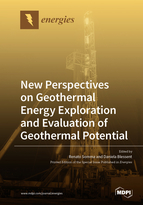New Perspectives on Geothermal Energy Exploration and Evaluation of Geothermal Potential
A special issue of Energies (ISSN 1996-1073). This special issue belongs to the section "H2: Geothermal".
Deadline for manuscript submissions: closed (31 December 2021) | Viewed by 25451
Special Issue Editors
2. IRISS-Istituto di Ricerca su Innovazione e Servizi per lo Sviluppo, Via Guglielmo Sanfelice, 8-80134 Napoli, Italy
3. ISMAR—Istituto di Scienze Marine Calata Porta Di Massa—Porto Di Napoli, 80-80133 Napoli, Italy
Interests: geochemistry; medical geology; geothermal energy; isotopes; environmental geochemistry; volcanology; natural disasters; public health; sensors
Special Issues, Collections and Topics in MDPI journals
Interests: geothermal energy
Special Issues, Collections and Topics in MDPI journals
Special Issue Information
During the past decade, strong efforts have been made to unravel the links between volcanic and non volcanic areas throughout the world and their geothermal energy resources. This effort, in volcanic areas, has provided the basis for converting volcanic risk into a potential clean energy resource, especially in densely inhabited areas. Due to the increasing need for energy in emerging countries, it becomes necessary to characterize geothermal reservoirs as either low/intermediate-temperature resources (for heating and cooling of buildings, district heating, and greenhouses) or high-temperature resources (for electricity generation or co-generation). On the other hand, high-temperature geothermal resources are exploited through deep wells (1–5 km) drilled to reach reservoirs, which can be located in highly heterogeneous volcanic complexes, sedimentary basins, or old basement rocks. Reservoir permeability can be enhanced through different engineering techniques to improve productivity, although such techniques may raise hard problems of social acceptability. Low or intermediate temperature resources are exploited within shallow (few meters) or intermediate boreholes (up to 1 km) and mostly provide heating and cooling capacity. In recognition of these conditions, development of a robust interdisciplinary methodology to characterize such geothermal systems from a volcanological, geophysical, geochemical, and geo(hydro)thermal point of view is fundamental. We welcome contributions pertaining to all these disciplines in order to quickly locate areas within volcanic complexes, sedimentary basins, or old basement rock that are most likely to contain exploitable hydrothermal systems. Well calibrated, multidisciplinary geophysical and geochemical investigation can greatly reduce uncertainties involved in the determination of the geothermal potential, thus stimulating the use of resources able to reduce environmental pollution in emerging countries and in densely populated areas worldwide.
Dr. Renato Somma
Prof. Daniela Blessent
Guest Editors
Manuscript Submission Information
Manuscripts should be submitted online at www.mdpi.com by registering and logging in to this website. Once you are registered, click here to go to the submission form. Manuscripts can be submitted until the deadline. All submissions that pass pre-check are peer-reviewed. Accepted papers will be published continuously in the journal (as soon as accepted) and will be listed together on the special issue website. Research articles, review articles as well as short communications are invited. For planned papers, a title and short abstract (about 100 words) can be sent to the Editorial Office for announcement on this website.
Submitted manuscripts should not have been published previously, nor be under consideration for publication elsewhere (except conference proceedings papers). All manuscripts are thoroughly refereed through a single-blind peer-review process. A guide for authors and other relevant information for submission of manuscripts is available on the Instructions for Authors page. Energies is an international peer-reviewed open access semimonthly journal published by MDPI.
Please visit the Instructions for Authors page before submitting a manuscript. The Article Processing Charge (APC) for publication in this open access journal is 2600 CHF (Swiss Francs). Submitted papers should be well formatted and use good English. Authors may use MDPI's English editing service prior to publication or during author revisions.
Keywords
- geothermal energy
- volcanic districts
- geothermal productivity
- hydrology of geothermal systems
- induced seismicity
- low enthalpy
- high enthalpy
- hydrogeology
- modeling of fractured geological media
- numerical modeling of groundwater flow
- heat transfer
- transport of contaminants
- characterization of geothermal resources







